Provider Turnover Trends Across Medical Groups: Insights from Premier’s Provider Practice Benchmarking Data

Key Takeaways:
- According to a new Premier study, over the past two years, one in every five providers in U.S. medical groups is new to their practice, highlighting a notable turnover rate affecting both physicians and advanced practice providers (APPs).
- There’s a gradual shift towards recruiting more APPs than physicians, with certain specialties such as urgent care, orthopedic surgery and family medicine experiencing higher proportions of APP hires.
- Turnover is influenced by various factors including organizational changes, workplace culture and job satisfaction, making it essential for medical groups to prioritize retention strategies to mitigate its financial and operational impacts.
Physician and advanced practice providers (APPs) turnover remain an ongoing challenge for medical groups nationwide, requiring a nuanced understanding of the underlying factors and effective strategies for navigating this issue.
A new study combing Premier’s PINC AI™ Provider Practice Benchmarking data offers a deep dive into these trends, uncovering some eye-opening insights that shed light on the state of physician and APP turnover and recruiting in the healthcare industry.
The Magnitude of Change
According to the study, over the past two years, roughly one in every five providers in medical groups across the United States were new to their practice. That's a staggering statistic, highlighting the significant turnover rate within medical groups.

Source: PINC AI™ Provider Practice Benchmarking Dataset
Understanding Departures
Of the providers who left their medical groups, 68 percent were physicians while 32 percent were APPs. Notably, the departure rate in 2022 was higher compared to 2023, which we believe could be attributed to the lingering effects of COVID-19 burnout.
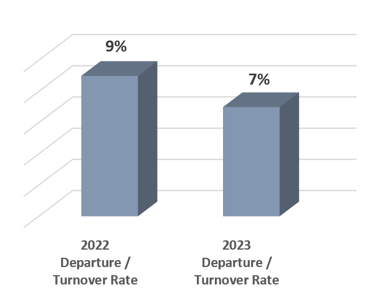
Source: PINC AI™ Provider Practice Benchmarking Dataset
Understanding departure rates provides valuable insights into provider tenure, with specialists generally exhibiting longer tenures compared to primary care providers.
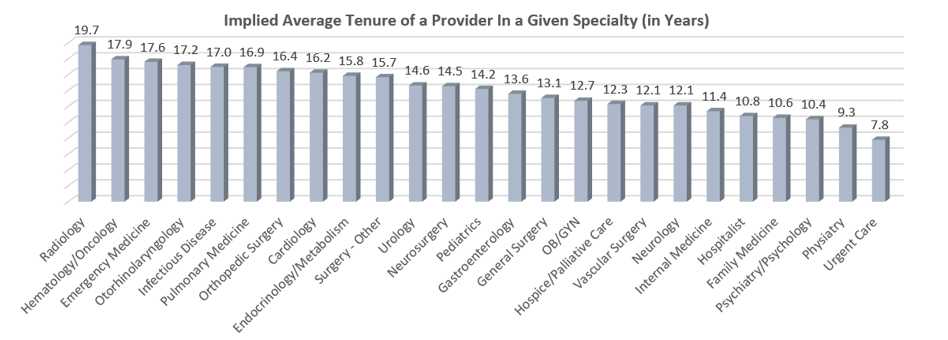
Source: PINC AI™ Provider Practice Benchmarking Dataset
Further, about 12 percent of departures resulted from medical groups divesting practices or service lines. The highest divestment rates were found in physiatry, urgent care, hospitalist programs and ENT. The fewest divestments were found in urology, emergency medicine, neurosurgery and gastroenterology. This sheds light on how the strategic decisions made by medical groups to realign their focus or streamline operations impact workforce composition.
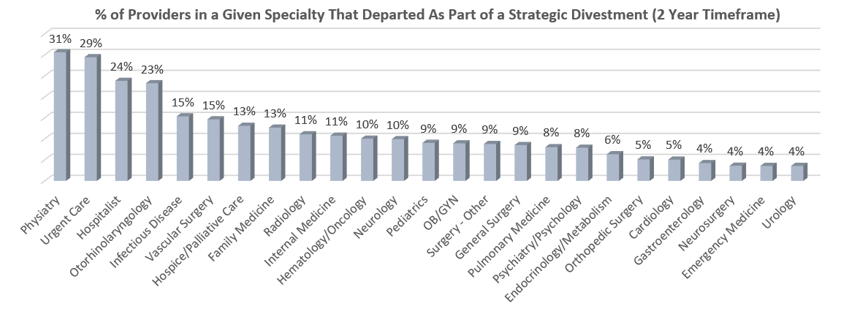
Source: PINC AI™ Provider Practice Benchmarking Dataset
Examining New Additions
In contrast, 63 percent of new hires were physicians, while 37 percent of new hires were APPs. This distribution reflects the evolving dynamics in healthcare delivery, with a gradual shift towards recruiting more APPs than physicians.
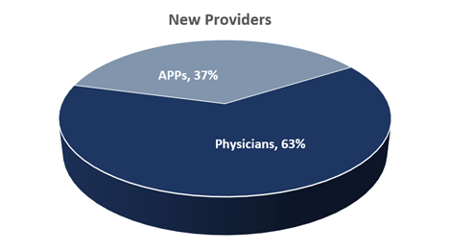
Source: PINC AI™ Provider Practice Benchmarking Dataset
The study also examined the distribution of new hires across specialties, revealing interesting trends. For instance, urgent care, orthopedic surgery and family medicine witnessed a higher proportion of APP hires, suggesting a growing reliance on APPs in certain specialties.
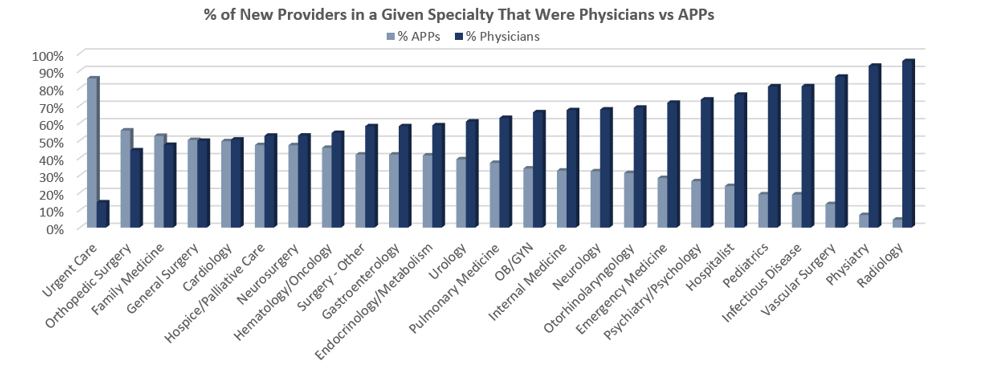
Source: PINC AI™ Provider Practice Benchmarking Dataset
Moreover, medical groups are strategically expanding their services in specific specialties such as ENT, OB/GYN, emergency medicine and physiatry. This strategic focus on expansion underscores the importance of aligning organizational growth initiatives with patient needs and market demands.
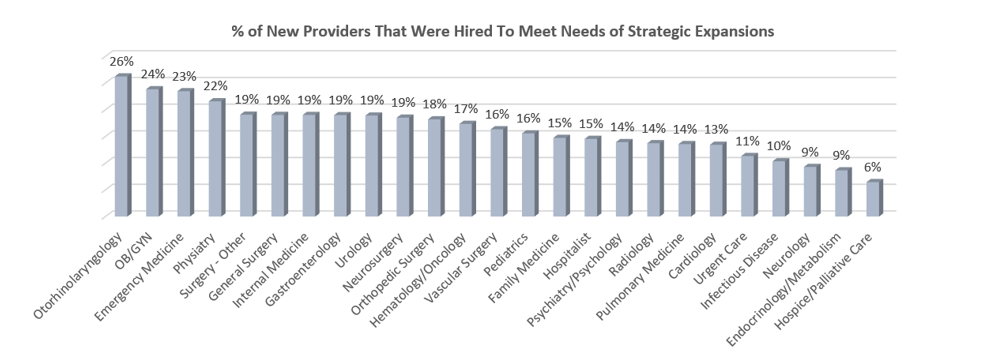
Source: PINC AI™ Provider Practice Benchmarking Dataset
Digging deeper, it becomes clear that the reasons behind hiring new providers are multifaceted. Sixty one percent newly hired physicians and APPs are brought on board to fill vacancies left by departing providers. Additionally, 22 percent of new hires were to accommodate organic growth, while 17 percent were part of strategic expansions, underscoring the diverse drivers behind recruitment efforts. This suggests that turnover isn't just a matter of natural attrition; it's also influenced by factors such as organizational changes, workplace culture and job satisfaction.
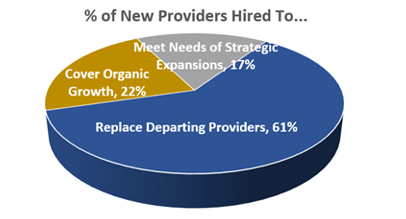
Source: PINC AI™ Provider Practice Benchmarking Dataset
PINC AI™ Provider Practice Benchmarks: Empowering Medical Group Performance
It's essential to recognize that turnover isn't just a logistical headache; it also may come with a hefty price tag. From the time it takes to find and onboard a new provider to the financial costs associated with recruitment and training, turnover can take a significant toll on medical group finances. That's why prioritizing provider retention is crucial. By fostering a supportive work environment, offering professional development opportunities and promoting work-life balance, medical groups can create a culture that encourages providers to stay for the long haul.
The PINC AI™ Provider Practice Benchmarking aggregates disparate data from multiple sources, allowing medical group leadership to measure, monitor and manage 650+ critical metrics across seven functional areas with a single source of truth. This transparent and actionable data identifies opportunities and performance gaps that can be leveraged to improve access, increase revenue and manage costs.
Final Thoughts
The insights gleaned from the PINC AI™ Provider Practice Benchmarking data shed light on the multifaceted nature of physician and APP turnover and recruiting within medical groups. The PINC AI™ Provider Practice solution provides invaluable insights enabling organizations to identify patterns and trends. These benchmarks help uncover underlying issues, allowing targeted interventions to improve provider satisfaction and retention strategies.
Concurrently, the PINC AI™ Advisory Services team offers tailored guidance and strategic support leveraging industry expertise and leading practices. Advisors partner from assessment to implementation, identifying areas for improvement and implementing effective solutions. By leveraging data-driven insights alongside expert guidance to understand the underlying trends and drivers of turnover, healthcare leaders can proactively address challenges, optimize recruitment efforts and cultivate a resilient workforce that delivers high-quality care to patients.
Methodology
Our analysis focused on the 24-month period from October 2021 to September 2023 (data extending back to July 2021 and up to December 2023 was also used as needed to ensure accurate results). Using the following criteria, every provider in Premier’s PINC AI™ Provider Practice Benchmarking dataset was assigned to one of four categories:
- Retained Provider: Any provider in a given medical group that generated at least 20 Relative Value Units (RVUs) (based on service provider and service date) in at least 20 of the 24 months (up to three month gap is allowed to account for maternity, FLMA or other types of leave of absence), as long as the gaps in activity do not occur in the first or last three months of the time period (in those cases, the provider would be categorized as new or departed, as described below).
- New Provider: Any provider whose 20+ monthly RVU activity started during the 24-month period, with no gaps in activity of greater than three months after the start date.
- Note on Strategic Expansion: If the majority (70 percent or more) of providers in a large (4+ providers) practice/cost center all had the same start date (within three months of each other), our analysis assumes that those providers were added to the medical group as part of a strategic expansion.
- Note on Strategic Expansion: If the majority (70 percent or more) of providers in a large (4+ providers) practice/cost center all had the same start date (within three months of each other), our analysis assumes that those providers were added to the medical group as part of a strategic expansion.
- Departed/Terminated Provider: Any provider whose 20+ monthly RVU activity ended during the 24-month period, with no gaps in activity of greater than three months before the end date.
- Note on Strategic Divestments: If the majority (70 percent or more) of providers in a large (4+ providers) practice/cost center all had the same end date (within three months of each other), our analysis assumes that those providers were terminated from the medical group as part of a strategic divestment.
- Note on Strategic Divestments: If the majority (70 percent or more) of providers in a large (4+ providers) practice/cost center all had the same end date (within three months of each other), our analysis assumes that those providers were terminated from the medical group as part of a strategic divestment.
- Other Providers (excluded from analysis): Any provider that did not meet the criteria for one of the three above categories, or whose specialty is not a physician or APP, was excluded from the analysis. Essentially, these are providers with very sporadic RVU activity over the time period (likely due to locums or other types of temporary coverage) or social workers and other types of non-physician or APP providers.
Throughout the analysis, we used provider headcount (not FTEs), since it takes essentially the same resources to retain, recruit or terminate a provider, regardless of FTE status.
Methodology examples:
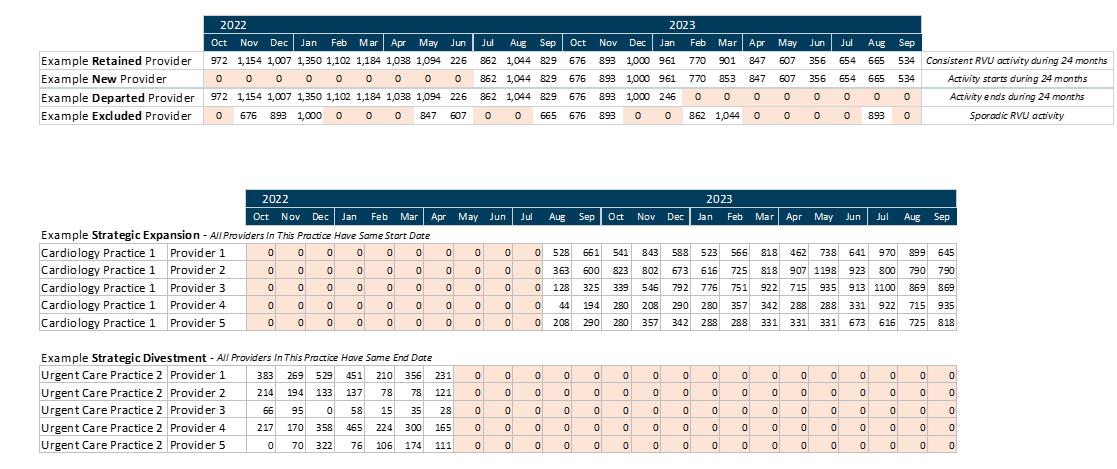
Source: PINC AI™ Provider Practice Benchmarking Dataset
Learn More:
- For more information about Premier and our practice benchmarking solutions, contact solutioncenter@premierinc.com.
The insights you need to stay ahead in healthcare: Subscribe to Premier’s Power Rankings newsletter and get our experts’ original content delivered to your inbox once a month.
During her consulting career, Kearin has delivered large integrated consulting engagements in community systems, academic health systems and standalone specialty hospitals across the U.S. Her areas of expertise include medical group operations and financial performance, strategic plan development, change management, leadership and organizational structure redesign, and physician governance creation/redesign.
Article Information
During her consulting career, Kearin has delivered large integrated consulting engagements in community systems, academic health systems and standalone specialty hospitals across the U.S. Her areas of expertise include medical group operations and financial performance, strategic plan development, change management, leadership and organizational structure redesign, and physician governance creation/redesign.